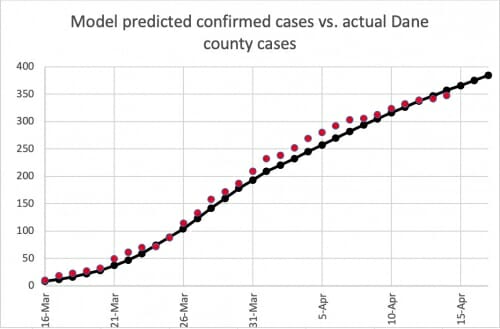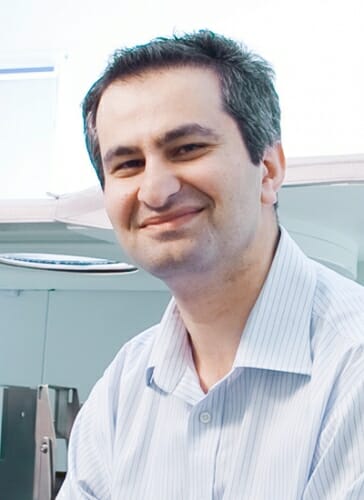UW–Madison engineer works with local health leaders to develop COVID-19 prediction models
A University of Wisconsin–Madison industrial engineer has led the development of models that are among the tools aiding health officials in Dane County and south-central Wisconsin as they prepare for and respond to COVID-19.
Oguzhan Alagoz, a professor of industrial and systems engineering at UW–Madison and an expert in infectious disease modeling, has worked closely with colleagues in the School of Medicine and Public Health and at UW Health to develop and refine them. He has also shared his efforts with the Wisconsin Department of Health Services.
The models use a swath of relevant, research-based parameters to predict the number of cases of COVID-19 in the region. They use, for example, the age distribution of residents, population density, how closely residents are adhering to social distancing guidelines, and whether people are traveling into or out of the area. They also include a relatively conservative approach to testing for COVID-19, transmission from patients without any symptoms, disease transmission rates, and other variables that aid in prediction.
“Because this is a public health issue, predictions can change public social distancing behavior,” Alagoz says. “Or after four weeks of social distancing, for example, will people get sick of it and see the numbers of positive COVID-19 cases are not bad and start to relax their behavior?”
To refine the models based on local health system experiences and COVID-19 response planning, Alagoz has collaborated with Nasia Safdar, professor of medicine at the School of Medicine and Public Health and medical director of infection control at UW Hospital and Clinics; Ajay Sethi, professor of population health sciences at SMPH; and a team led by Frank Liao, director of data science and advanced analytics at UW Health.
They have worked together as a team for more than four weeks to localize and tailor the models to effectively inform important, operational decision-making for the benefit of the health system and the community, says Liao.

The models use a swath of relevant, research-based parameters to predict the number of cases of COVID-19 in the region. The black line indicates predicted cases and the red dots represent actual cases. Courtesy of Oguzhan Alagoz
To create them, Alagoz drew on his expertise in infectious disease modeling and used an agent-based simulation model, which considers the individual contributions that interact to create a more complex system.
“Working with Oguz has been a great collaboration and partnership – he is an integral member of the UW Health modeling team and the agent-based model is an important and powerful approach in our efforts,” Liao adds. “While the modeling team uses multiple models, the partnership is much more than simply providing another set of inputs.”
In the context of the pandemic, decision-makers weigh predictions from several models, similarly to the way in which weather models serve an important role in forecasts, particularly during a storm. Experts typically rely on several different models to arrive at a consensus prediction.
While predictive models have clear limitations — especially during an outbreak of a novel virus — well-constructed models are an important tool in pandemic response.
“Because this is a public health issue, predictions can change public social distancing behavior,” Alagoz says.
Building the models arose out of Alagoz’s desire to provide decision-makers with another data-based option. He says the work has been among the most challenging experiences of his career. “We spent five years building a model for hospital-acquired infections, two years building a model for tuberculosis transmission, and less than three weeks to model COVID-19,” he says.
The project also isn’t the first collaboration for Safdar and Alagoz, who have worked together several times over the last decade.
“The agent-based modeling that Oguz creates directly informs infection control work and practices for COVID-19, but also for other existing and emerging pathogens,” she says. “We are fortunate to have such a resource on our campus.”
The modeling is most useful under local contexts and can take into account public policy decisions such as stay-at-home orders, school closures, and travel restrictions. Alagoz says his model can easily be adjusted to other states or other regions.
Over the short run, he feels very confident in his results. He is in the process of validating the models by comparing their predictions against others and against actual reported data. So far, Alagoz’s estimates have been encouraging.
However, the pandemic is an exceptionally dynamic situation and he will need to continue fine-tuning the parameters in his models. Rapidly changing variables also means he is hard-pressed to predict the peak of Wisconsin and Dane County’s COVID-19 epidemic.
“We are, as a community, going to determine our peak date,” Alagoz says. “It all depends on how people in our community behave. They just need to keep up their great work. We have a light at the end of the tunnel; it’s just that we need to be patient until that is the case.”
Enjoy this story?
Read more news from the College of EngineeringTags: College of Engineering, covid-19, health, research

